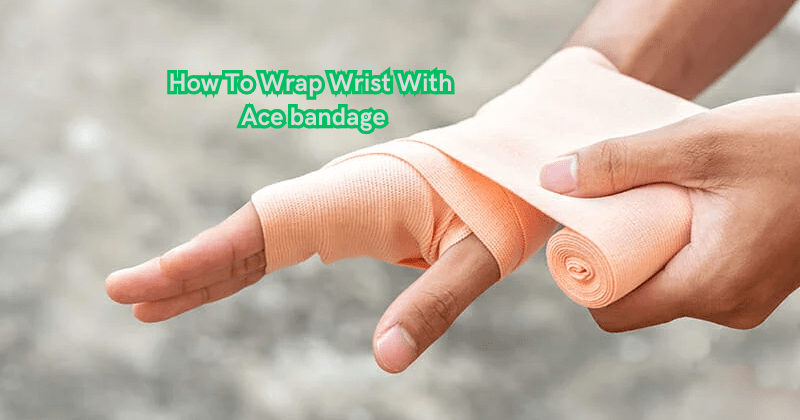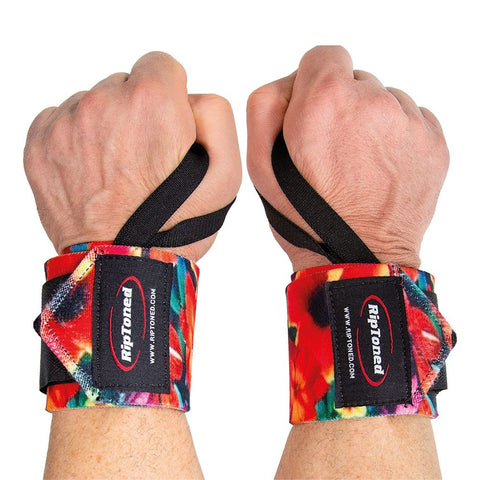
How To Wrap Wrist With Ace bandage
Share
The wrist is one of the most commonly injured areas in the body because it is constantly used for everyday tasks. Injuries to the wrist can range from minor sprains to more serious fractures, and they can greatly affect a person's ability to perform daily activities.
Wrist injuries are especially common among athletes and individuals who participate in physical activities that involve repetitive motions or impact. To aid in the healing process and prevent further injury, an Ace bandage can be used to wrap the wrist for support and stability. This guide will provide step-by-step instructions on how to properly wrap a wrist with an Ace bandage.
What is an Ace bandage?
An Ace bandage, also known as an elastic bandage, is a versatile and commonly used medical wrap that provides support and compression to injured body parts. It is made of a stretchable fabric that allows for flexibility and easy movement while providing the necessary support. The name "Ace" comes from the brand name of 3M, the company that first introduced this type of bandage in the 1920s.
Ace bandages come in various widths and lengths to accommodate different body parts. They are typically made of cotton, polyester, or both materials. Some Ace bandages have metal clips or velcro closures for easy fastening and adjusting.
Aside from wrapping injuries, Ace bandages can also be used for compression therapy to reduce swelling and promote healing. They are commonly used for sprained ankles, knee injuries, and other joint injuries. Now that you know what an Ace bandage is, let's move on to how to properly wrap a wrist with one.
Step-by-step guide for wrapping a wrist with an Ace bandage
Before you begin, make sure you have a clean and dry Ace bandage that is the appropriate size for your wrist. You may also need some medical tape to secure the end of the bandage.
Step 1: Start at the hand
The first step in wrapping a wrist with an Ace bandage is to start at the hand. Hold the loose end of the bandage in one hand and place it on the inside of your hand, near the base of your thumb. Make sure that the sticky side is facing down towards your palm.
Also, make sure that the bandage is positioned slightly below your thumb so that it can be wrapped around the wrist comfortably. Hold the end in place with your thumb or fingers and wrap the bandage once around your hand to secure it in place. This will be the starting point for wrapping the rest of your wrist.
Step 2: Wrap the bandage above the wrist
Next, continue wrapping the bandage around your hand and up towards your wrist. Keep the bandage flat and snug but not too tight as you wrap. You want to maintain consistent tension throughout the wrapping process.
As you reach the base of your fingers, cover your knuckles with the bandage and continue wrapping upwards. This will provide extra support for your hand and wrist.
Step 3: Make figure-eight turns around the wrist
Once you have reached the base of your fingers, start making figure-eight turns around your wrist. Start by wrapping the bandage downwards towards your palm, then cross over the back of your hand and wrap it upwards towards your wrist. Continue making figure-eight turns until you have covered the entire wrist area.
Make sure to overlap each turn by about half of the bandage's width to ensure even compression and support. Also, make sure not to wrap too tightly as this can restrict blood flow and cause discomfort.
Step 4: Secure the end of the bandage with medical tape
Once you have wrapped the entire wrist, secure the end of the bandage with medical tape. This will prevent it from coming undone and provide extra stability. Make sure to wrap the tape around a few times to ensure it is firmly in place.
You can also tuck any extra bandage under the previously wrapped layers for added security. This will also prevent loose ends from getting caught on clothing or other objects.
Step 5: Check for proper tightness and adjust if necessary
After securing the end of the bandage, check for proper tightness by moving your hand and wrist around. The bandage should feel snug but not too tight. If you experience any numbness, tingling, or increased pain, the bandage may be too tight and should be loosened.
Additionally, regularly check on your wrist throughout the day and adjust the bandage if it becomes loose. It is important to maintain proper support and compression for optimal healing.
So there you have it, a step-by-step guide on how to properly wrap a wrist with an Ace bandage. Remember to always consult with a medical professional if you have any concerns or questions about your injury. With proper support and care, your wrist will be on its way to healing in no time!
Why is it important to learn how to wrap a wrist with an Ace bandage?
Learning how to properly wrap a wrist with an Ace bandage is essential for anyone who participates in physical activities and sports. Wrapping the wrist provides stability and support, which can help prevent further injury and promote healing.
Moreover, knowing how to wrap a wrist can be helpful in emergencies where immediate support and compression are needed. By learning this skill, you can be prepared to provide first aid for yourself or others.
Additionally, improper wrapping techniques can do more harm than good. For example, wrapping too tightly can restrict blood flow and cause discomfort, while wrapping too loosely may not provide enough support. Therefore, it is important to learn the proper technique to ensure the best possible outcome for your injury.
Also, by properly wrapping a wrist with an Ace bandage, you can save time and money by avoiding unnecessary trips to the doctor or physical therapist. By taking care of minor injuries at home, you can also prevent them from worsening and potentially requiring more extensive medical treatment.
Does wrapping a wrist with an Ace bandage have any potential risks?
While wrapping a wrist with an Ace bandage can provide many benefits, it is important to be aware of the potential risks as well. The most common risk associated with using an Ace bandage is improper wrapping, which can cause discomfort and restrict blood flow.
It is also possible for the bandage to slip or become too loose, which can reduce its effectiveness in providing support. This could potentially lead to re-injury or delay healing.
Additionally, wrapping a wrist too tightly can also cause nerve damage, leading to numbness and tingling in the hand and fingers. It is important to regularly check on your wrist while it is wrapped and adjust the bandage if necessary.
If you have any concerns or experience unusual symptoms while using an Ace bandage, it is best to consult with a medical professional for guidance. They can also provide advice on the appropriate duration and frequency of wrapping based on your specific injury.
Tips for maintaining wrist health and preventing injuries
Aside from knowing how to properly wrap a wrist with an Ace bandage, there are also other ways to maintain wrist health and prevent injuries. Some tips include:
- Stretching and strengthening exercises: Regularly stretching and strengthening the muscles and tendons in your wrists can help improve their flexibility and strength, making them less prone to injury.
- Wearing protective gear: If you participate in sports or activities that involve repetitive hand and wrist movements, it is important to wear proper protective gear, such as gloves or wrist guards.
- Taking breaks: Frequent breaks from activities that strain the wrists, such as typing on a computer or using hand tools, can help prevent overuse injuries.
- Maintaining good posture: Poor posture can put unnecessary strain on the wrists, leading to discomfort and potential injuries. It is important to maintain good posture throughout the day.
- Listening to your body: Lastly, it is important to listen to and pay attention to any warning signs of potential wrist injuries. If you experience pain or discomfort, take a break and modify your activities as needed. Seeking medical attention if symptoms persist is also important for proper diagnosis and treatment.
- Ergonomic workspace setup: If you spend a lot of time at a desk or computer, make sure your workstation is set up ergonomically to reduce strain on your wrists and arms. This can include using a wrist rest or an ergonomic keyboard and mouse.
By incorporating these tips into your daily routine, you can help maintain the health of your wrists and prevent injuries from occurring. Remember, taking care of your wrists now can prevent potential problems in the future.
FAQs
How can wrist wrapping with an ACE bandage help alleviate wrist pain from carpal tunnel syndrome?
Wrapping the wrist with an ACE bandage in a neutral position can provide support and compression, which may help reduce pain associated with carpal tunnel syndrome. However, it's important to consult a healthcare professional for personalized advice.
Is it safe to use an ACE bandage to wrap a sprained wrist?
Using an ACE bandage to wrap a sprained wrist can help provide support and stability, especially during the initial stages of injury. It is advisable to follow the R.I.C.E. (rest, ice, compression, elevation) protocol and seek medical attention for a severe wrist sprain.
How should I wrap my injured wrist with an ACE bandage to reduce pain and swelling?
To wrap an injured wrist with an ACE bandage, start by applying an ice pack to reduce swelling, then wrap the bandage snugly but not too tight around the affected area, ensuring it provides support and comfort to help reduce pain and swelling.
Can wrapping the wrist with an ACE bandage cause discomfort around the index finger?
When wrapping the wrist with an ACE bandage, ensure that it is done in a manner that avoids excessive pressure or discomfort around the index finger. Proper wrapping technique is crucial to avoid discomfort or constriction during wrist wrapping.
Conclusion
In conclusion, learning how to properly wrap a wrist with an Ace bandage is a valuable skill for anyone who leads an active lifestyle. It can provide support and stability for injured wrists, as well as prevent further injuries. However, it is important to be aware of potential risks and to seek medical attention if necessary.
By following the step-by-step guide and incorporating other tips for maintaining wrist health, you can ensure proper healing and prevent future injuries. Remember to always consult with a medical professional for any concerns or questions regarding your wrist injury. With proper care and support, your wrist will be on its way to recovery in no time.

